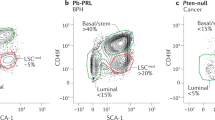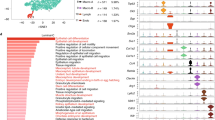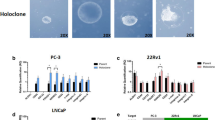Abstract
The successful isolation and cultivation of prostate stem cells will allow us to study their unique biological properties and their application in therapeutic approaches. Here we describe step-by-step procedures on the basis of previous work in our laboratory for the harvesting of primary prostate cells from adolescent male mice by a modified enzymatic procedure; the isolation of an enriched population of prostate stem cells through cell sorting; and the cultivation of prostate stem cells in vitro and characterization of these cells and their stem-like activity, including in vivo tubule regeneration. Normally, it will take approximately 8 h to harvest prostate cells, isolate the stem cell–enriched population and set up the in vitro sphere assay. It will take up to 8 weeks to analyze the unique properties of the stem cells, including their regenerative capacity in vivo.
This is a preview of subscription content, access via your institution
Access options
Subscribe to this journal
Receive 12 print issues and online access
$259.00 per year
only $21.58 per issue
Buy this article
- Purchase on Springer Link
- Instant access to full article PDF
Prices may be subject to local taxes which are calculated during checkout






Similar content being viewed by others
References
Blanpain, C., Horsley, V. & Fuchs, E. Epithelial stem cells: turning over new leaves. Cell 128, 445–458 (2007).
Barker, N. et al. Crypt stem cells as the cells-of-origin of intestinal cancer. Nature 457, 608–611 (2009).
Clarke, M.F. & Fuller, M. Stem cells and cancer: two faces of eve. Cell 124, 1111–1115 (2006).
Tsujimura, A. et al. Proximal location of mouse prostate epithelial stem cells: a model of prostatic homeostasis. J. Cell Biol. 157, 1257–1265 (2002).
Scher, H.I. & Sawyers, C.L. Biology of progressive, castration-resistant prostate cancer: directed therapies targeting the androgen-receptor signaling axis. J. Clin. Oncol. 23, 8253–8261 (2005).
Taplin, M.E. & Balk, S.P. Androgen receptor: a key molecule in the progression of prostate cancer to hormone independence. J. Cell. Biochem. 91, 483–490 (2004).
Burger, P.E. et al. High aldehyde dehydrogenase activity: a novel functional marker of murine prostate stem/progenitor cells. Stem Cells (Dayton, Ohio) 27, 2220–2228 (2009).
Burger, P.E. et al. Sca-1 expression identifies stem cells in the proximal region of prostatic ducts with high capacity to reconstitute prostatic tissue. Proc. Natl. Acad. Sci. USA 102, 7180–7185 (2005).
Goldstein, A.S. et al. Trop2 identifies a subpopulation of murine and human prostate basal cells with stem cell characteristics. Proc. Natl. Acad. Sci. USA 105, 20882–20887 (2008).
Lawson, D.A., Xin, L., Lukacs, R.U., Cheng, D. & Witte, O.N. Isolation and functional characterization of murine prostate stem cells. Proc. Natl. Acad. Sci. USA 104, 181–186 (2007).
Leong, K.G., Wang, B.E., Johnson, L. & Gao, W.Q. Generation of a prostate from a single adult stem cell. Nature 456, 804–808 (2008).
Wang, X. et al. A luminal epithelial stem cell that is a cell of origin for prostate cancer. Nature 461, 495–500 (2009).
Xin, L., Lawson, D.A. & Witte, O.N. The Sca-1 cell surface marker enriches for a prostate-regenerating cell subpopulation that can initiate prostate tumorigenesis. Proc. Natl. Acad. Sci. USA 102, 6942–6947 (2005).
Xin, L., Lukacs, R.U., Lawson, D.A., Cheng, D. & Witte, O.N. Self-renewal and multilineage differentiation in vitro from murine prostate stem cells. Stem Cells (Dayton, Ohio) 25, 2760–2769 (2007).
Lukacs, R.U. et al. Epithelial stem cells of the prostate and their role in cancer progression. Cold Spring Harb. Symp. Quant. Biol. 73, 491–502 (2008).
Pontier, S.M. & Muller, W.J. Integrins in mammary-stem-cell biology and breast-cancer progression—a role in cancer stem cells? J. Cell Sci. 122, 207–214 (2009).
Cunha, G.R. & Lung, B. The possible influence of temporal factors in androgenic responsiveness of urogenital tissue recombinants from wild-type and androgen-insensitive (Tfm) mice. J. Exp. Zool. 205, 181–193 (1978).
Xin, L., Ide, H., Kim, Y., Dubey, P. & Witte, O.N. In vivo regeneration of murine prostate from dissociated cell populations of postnatal epithelia and urogenital sinus mesenchyme. Proc. Natl. Acad. Sci. USA. 100 (Suppl 1): 11896–11903 (2003).
Acknowledgements
We thank Houjian Cai and Yang Zong for the helpful comments on the protocols and for showing the procedure in Supplementary Figure 2. R.U.L. was supported by the California Institute for Regenerative Medicine training grants (T1-00005 and TG2-01169). A.S.G. was supported by Ruth L. Kirschstein National Research Service Award GM07185. This work has also been supported by the Prostate Cancer Foundation Challenge Award for Defining Targets and Biomarkers in Prostate Cancer Stem Cells. O.N.W. is an investigator of the Howard Hughes Medical Institute.
Author information
Authors and Affiliations
Contributions
All the authors contributed to the development of the methodology. R.U.L., A.S.G. and O.N.W. contributed to the description of the protocols.
Note: Supplementary information is available via the HTML version of this article.
Corresponding author
Supplementary information
Supplementary Figure 1
Control plots for the FACS sorts (JPG 741 kb)
Supplementary Figure 2
Images of the subrenal prostate regeneration assay (JPG 550 kb)
Supplementary Figure 3
Images of tubules regenerated in the subrenal prostate regeneration assay. (JPG 433 kb)
Supplementary Table 1
Antibodies used for FMO (All Minus One) FACS compensation (see REAGENTS for company and catalogue number information). (PDF 55 kb)
Rights and permissions
About this article
Cite this article
Lukacs, R., Goldstein, A., Lawson, D. et al. Isolation, cultivation and characterization of adult murine prostate stem cells. Nat Protoc 5, 702–713 (2010). https://doi.org/10.1038/nprot.2010.11
Published:
Issue Date:
DOI: https://doi.org/10.1038/nprot.2010.11
This article is cited by
-
YAP is required for prostate development, regeneration, and prostate stem cell function
Cell Death Discovery (2023)
-
ARID1A loss induces polymorphonuclear myeloid-derived suppressor cell chemotaxis and promotes prostate cancer progression
Nature Communications (2022)
-
Prostate luminal progenitor cells: from mouse to human, from health to disease
Nature Reviews Urology (2022)
-
MEN1 silencing aggravates tumorigenic potential of AR-independent prostate cancer cells through nuclear translocation and activation of JunD and β-catenin
Journal of Experimental & Clinical Cancer Research (2021)
-
Klf5 acetylation regulates luminal differentiation of basal progenitors in prostate development and regeneration
Nature Communications (2020)
Comments
By submitting a comment you agree to abide by our Terms and Community Guidelines. If you find something abusive or that does not comply with our terms or guidelines please flag it as inappropriate.



